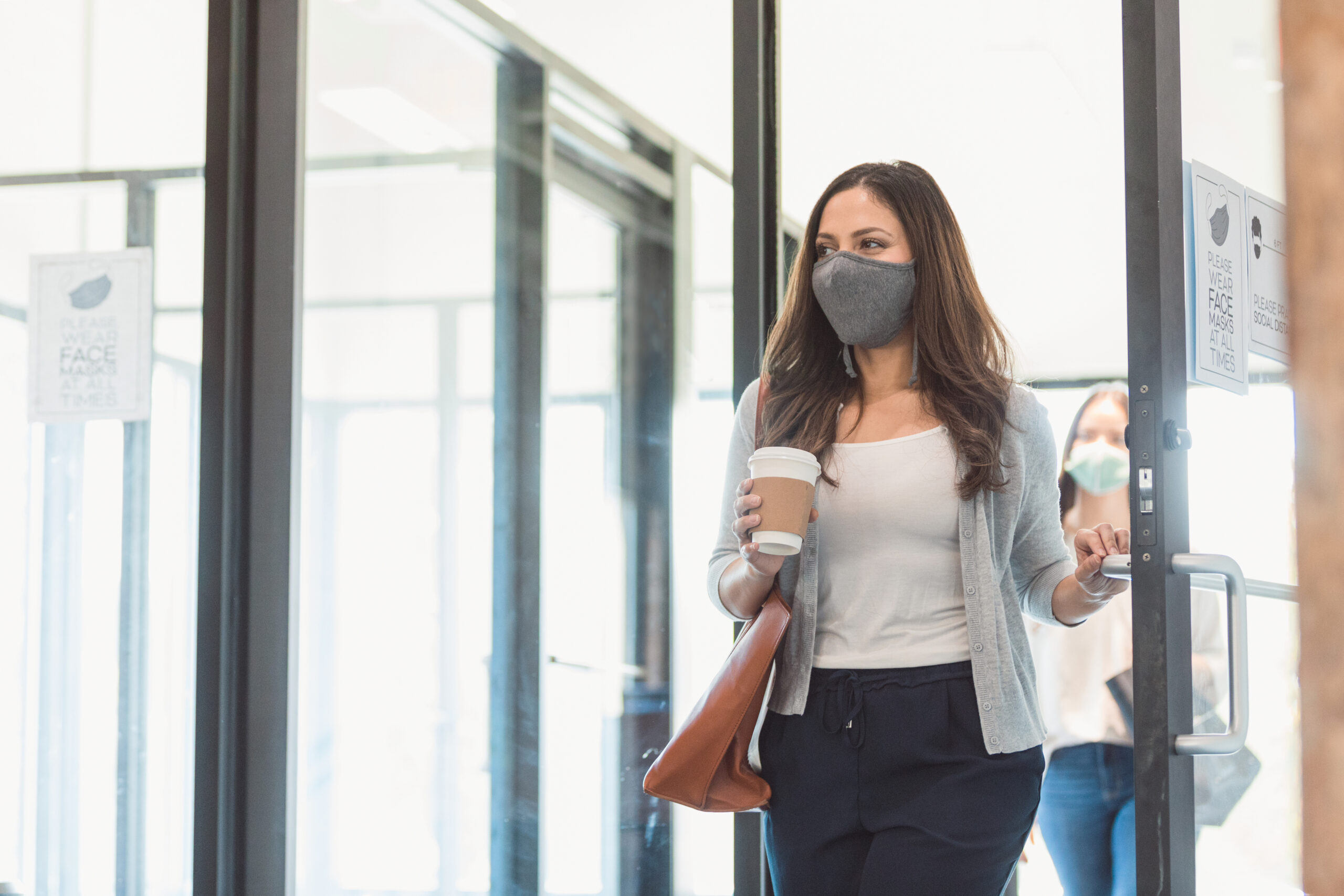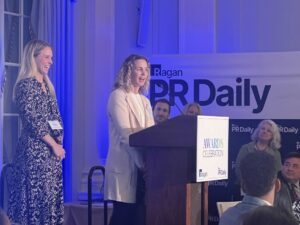How the tech company TaskUs anticipated the pandemic with its remote-work planning
The global digital-services company is pivoting to return-to-the-workplace based on its earlier groundwork.

A mid adult businesswoman enters her office during the COVID-19 pandemic. A colleague is walking behind her, practicing the proper social distancing protocol. The businesswomen are wearing protective face masks.
TaskUs, the global digital-services company, was in the process of building a remote-work infrastructure when the pandemic hit in March 2020. The intent was to expand its workforce geographically and emphasize employee diversity.
By using a cloud-based performance-management system, “we could send employees home to do a hub-and-spoke approach, where people could work both remotely in surrounding suburbs, or from a central office,” says Vice President of People Operations Brandy Rosner. The company, with 30,000 employees and based in New Braunfels, TX-based, purchased a range of equipment to support remote work, including cameras to video conferencing tools.

The initiative turned out to be prescient. The program, called the Cirrus Project, pivoted to help now-remote workers adjust to working from home. Now it’s being used in the company’s return-to-the-workplace efforts.
The vast majority of TaskUs employees are still remote. An estimated 30% of the company’s workforce have chosen to stay remote. To address concerns for those coming back to a common workplace, the company put safety procedures on the intranet and created an open Zoom call for employees to speak with an HR representative and ask questions. Global hotlines operate 24/7, and its shared services team is always available across time zones.
Rosner acknowledges that initial return-to-work messaging could have been better, but says it has been improved. When a few clients asked TaskUs to return to the site early, the initial wave of workers was fearful, despite the safety measures TaskUs had put in place. “We’ve learned to be even more communicative about the measures we have in place to ensure the safety of our team,” says Rosner. “After the initial first wave, we’ve done a tremendous job making sure that’s a smoother process.”
Rosner’s introspection on this point reflects the company’s broader “obsession” with workplace wellness. It has an award-winning wellness program and the numbers to back up its claims of effectiveness. A second-quarter 2021 employee survey (with a 90% participation rate) reported a nearly 64% employee net promoter score globally. eNPS is a metric for assessing how employees feel about a company. It was pioneered by Bain & Company to measure customer experience. TaskUs’s wellness department scored a 94% eNPS in 2020.
A robust wellness program
The overall goal is to provide an “unrivaled employee experience,” says Rachel Lutz-Guevara, vice president of global wellness and resiliency. “We believe that providing these fundamental, comprehensive programming offerings to employees really promotes not just their psychological safety but the well-being of people more broadly,” she says. “TaskUs believes that employees will benefit and that we’ll retain talent from delivering superior services that we think are best in class.”
The global wellness and resiliency team is a stand-alone department, which rolls up under content security. It often collaborates with HR, such as when onboarding new hires. The communications team, meanwhile, works with the wellness team to distribute messaging through various channels, including a monthly resilience round-up newsletter, a microsite, and the intranet. An internal system called BOOST, which facilitates employees with one-on-one manager meetings and personal goal-setting, also has a wellness element.

TaskUs uses a global wellness digital course catalog to offer ongoing resources to employees and leaders. While some resources are on-demand, others are by request. Leaders can schedule need-specific resources for their team from a resource provider. The catalog is categorized by region and need. There are numerous wellness opportunities, including 700 hours of proprietary courses, 10 employee resource groups, and onsite and digital wellness tools. Employees can access these depending on their needs, either through internal programs or external vendors.
For example, September’s program offerings focused on suicide prevention and awareness, but there are suicide-themed resources available year-round in the catalog, says Lutz-Guevara.
Overall, the wellness program focuses on two areas: global life coaching for internal employees and wellness opportunities that touch on employee life cycles. A global life-coaching program emphasizes transformational coaching rooted in positive psychology. “It aids employees in transforming beliefs and thinking patterns,” Lutz-Guevara says. “It’s strengths-based, so it’s preventative care to help employees reach goals and milestones in their career that are going to benefit them.”
Measurement encourages success
TaskUs uses a wellness scorecard to create a clean presentation of the 40 different sets of wellness data it routinely collects.
An algorithm weights the data into three categories: well-being, utilization, and effectiveness.
“It produces a key performance indicator out of 100%, so it’s a little bit more simplistic and holistic view of our employee wellness experience and allows us to make decisions based on evidence versus assumptions, so we’re able to produce that back into the business and to external clients as well,” says Lutz-Guevara.
The wellness team uses a proactive, preventative approach. After comparison studies by its internal behavioral health research team, this model increased employee KPI by 4% and provided higher wellbeing metrics over other methods.
“There’s an investment in these employees to produce the services we offer, but as far as the return, we see the return from a preventive care model,” says Lutz-Guevara. “So, instead of waiting for employees to seek services, we’re proactive in providing services, and those efforts show in our employee wellbeing metrics, lower attrition and higher KPIs.”
COMMENT
Ragan.com Daily Headlines
RECOMMENDED READING
How I got here: Joel Johnson on the key to excellence in storytelling
Tags: Measurement, return to work, TaskUs, tech, wellness programs






